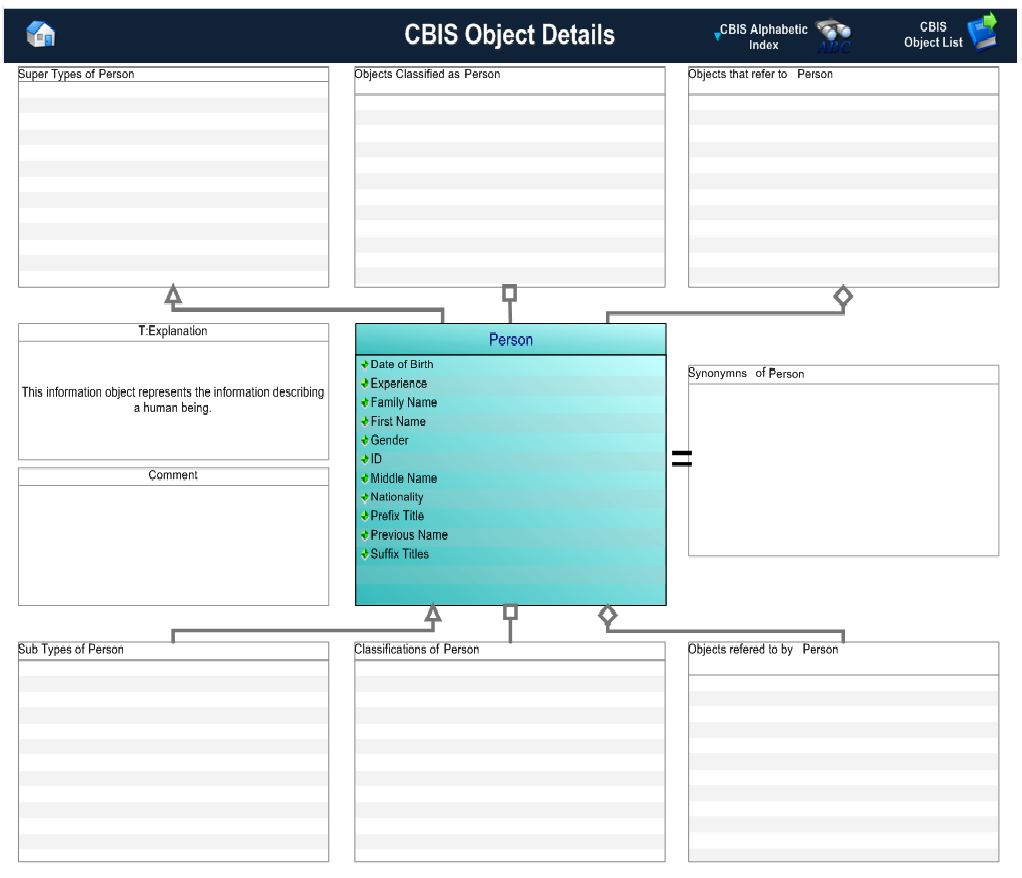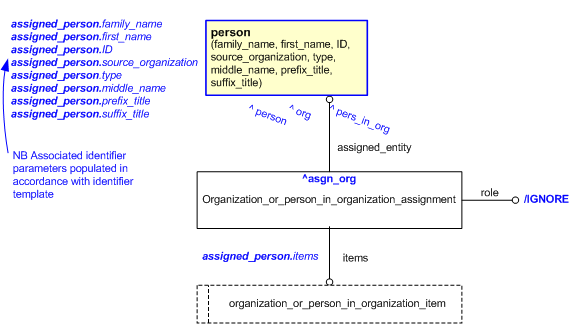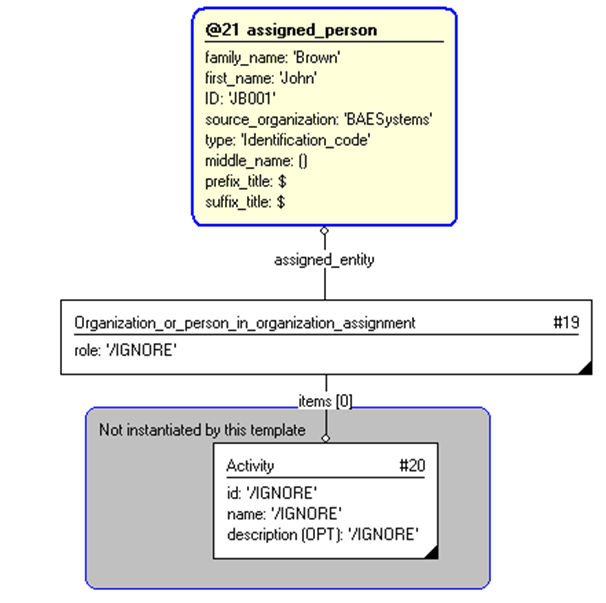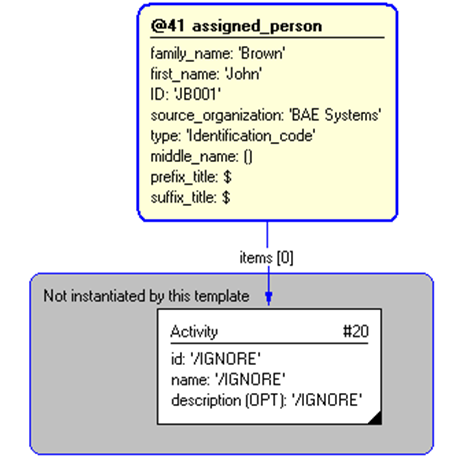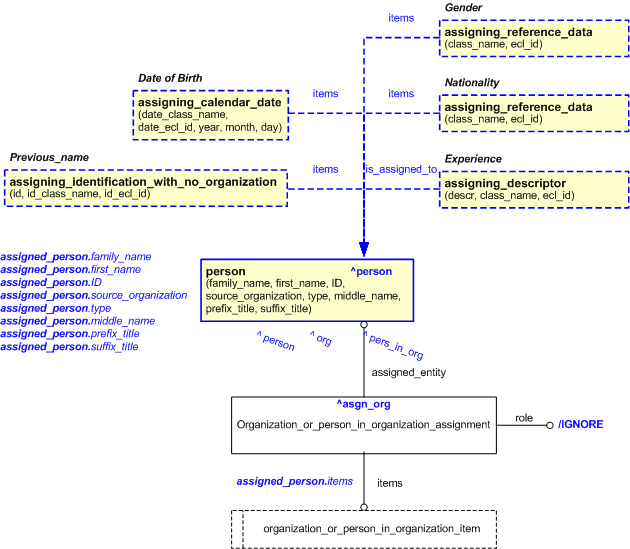Template:— assigned_person (asgd_pers)
Context:— UK_Defence |
Date: 2009/04/17 10:23:02
Revision: 1.2
|
This section specifies the template assigned_person.
NOTE
The template has been defined in the context of
UK_Defence.
Refer to the business context for details of related templates.
NOTE
An explanation of a template and the associated instantiation path is
provided in the
Template overview
section.
This template describes how to represent a UK_Defence assigned person, using
Person.
This represents the information describing the allocation of a human being to something.
For further information about the representation of the allocation of a person, see below.
This information object represents the information describing the allocation of a human being to something.
Figure 1 — Graphical Representation for Business Object Person
Record:
The definition of a assigned person object is:
This information object represents information about the allocation of a human being.
|
Attribute name
|
Attribute description
|
Attribute type
|
Optionality
|
| Date of Birth |
This is the date on which the person was born. |
Intrinsic |
Optional |
| Experience |
This is the description of the experience that a person possesses. |
Intrinsic |
Optional |
| Family Name |
This is the family name / surname of the person. |
Intrinsic |
Mandatory |
| First Name |
This is the first given name of the person. |
Intrinsic |
Mandatory |
| Gender |
This is the gender of the person (male / female). |
Intrinsic |
Optional |
| ID |
This is the identifier of the person. |
Identifier |
Mandatory |
| Middle Name |
This is the (list of) middle name(s) of the person. |
Intrinsic |
Optional |
| Nationality |
This is the (list of) nationalities of the person. |
Intrinsic |
Optional |
| Prefix Title |
This is the (list of) prefix title(s) that a person may prepend to their name. Examples may include: Mr, Mrs, Ms, Dr, Professor |
Intrinsic |
Optional |
| Suffix Titles |
This is the (list of) suffix title(s) that a person may append to their name. Examples may include: BSc, PhD, CEng, OBE |
Intrinsic |
Optional |
Table 1 — Person attribute details
The EXPRESS-G diagram in
Figure
2
shows the templates and EXPRESS entities that are required
to represent the template
"assigned_person".
The text highlighted in blue shows the template parameters.
Figure 2 — An EXPRESS-G representation of the Information model for assigned_person
The graphic for the template to be used in other EXPRESS-G diagrams
is shown in Figure
3
below.
Figure 3 — The graphical representation of the assigned_person template
The following input parameters are defined for this template:
The family name / surname of the person.
The first given name of the person.
The identifier of the person.
The organization that created the associated identifier. Additionally
a Person or Information System could be defined when either of these are the source; see characterizations
This is the name of the type of the class used to classify the identifier and so
provide the role or reason for the identification.
The following classes and their sub-classes can be used:
The (list of) middle name(s) of the person.
The (list of) prefix title(s) that a person may prepend to their name.
The (list of) suffix title(s) that a person may append to their name.
The items to which the person is assigned
The following reference parameters are defined for this template:
Allow the
Person
entity instantiated in this path to be referenced when this template is used.
Note: The
Person
entity can be referenced in a template path by:
%^target = $assigned_person.person%
where
target
is the parameter to which the
Person
is bound.
Allow the
Organization
entity instantiated in this path to be referenced when this template is used.
Note: The
Organization
entity can be referenced in a template path by:
%^target = $assigned_person.org%
where
target
is the parameter to which the
Organization
is bound.
Allow the
Person_in_organization
entity instantiated in this path to be referenced when this template is used.
%^target = $assigned_person.pers_in_org%
The following parameter combinations specify a uniqueness constraint:
Unique constraint: Unique id
Each instance of the
entity
(
Person)
within the data set shall be uniquely identified
by the following parameters on this
template (assigned_person) namely:
ID.
The
instance is
referenced by the following template parameter:
person.
The instantiation path shown below specifies the entities that are to be
instantiated by the template.
A description of templates and the syntax for the instantiation path is
provided in the
Templates Help/Information section.
The following entities are instantiated with attributes as specified:
The instance diagram in Figure
4
shows an example of the EXPRESS entities and templates that are instantiated by the template:
/assigned_person(family_name='Brown', first_name='John', ID='JB001', source_organization='BAE Systems', type='Identification_code', middle_name='', prefix_title='', suffix_title='', items='#20')/
(an illustration of the consolidated assigned_person template is shown in
Figure
5 below.)
Figure 4 — Entities instantiated by assigned_person template
The instance diagram in
Figure
5
shows the graphic symbol for the template that is to be
used in other instance diagrams. The example template is:
/assigned_person(family_name='Brown', first_name='John', ID='JB001', source_organization='BAE Systems', type='Identification_code', middle_name='', prefix_title='', suffix_title='', items='#20')/
Figure 5 — Instantiation of assigned_person template
The following section details how the
assigned_person
template can be optionally characterized by assigning
other constructs to it. These are characterizations commonly
applied to the template. The ISO 10303-239 EXPRESS model may enable
other assignments to the entities instantiated by the template.
The EXPRESS-G diagram in Figure
6
shows the possible characterizations of the template
"assigned_person".
Figure 6 — Characterizations for assigned_person
The following characterizations may apply:
Characterization Person's Experience
NOTE this characterization is optional.
The experience a person possesses can be represented using instances
of the template assigning_descriptor.
These are applied to the ^person reference parameter. See Figure 6 for the an abstract view of this.
The following template call shows how this might be instantiated with respect to Figure 5.
/assigning_descriptor(descr='nnn', class_name='Experience', ecl_id='urn:plcs:rdl:uk_defence', is_assigned_to='#41')/
Characterization Nationality
NOTE this characterization is optional.
The list of a person's nationalities is provided using instances of the template assigning_reference_data.
These are applied to the ^person reference parameter. See Figure 6 for the an abstract view of this.
The following template call shows how this might be instantiated with respect to Figure 5.
NOTE
The assignment of Nationalities is described the capability C010: assigning_reference_data.
The following template call shows how this might be instantiated with respect to
Figure 5.
/assigning_reference_data(class_name='Nationalities', ecl_id='urn:plcs:rdl:uk_defence', items='#41')/
Characterization Gender
NOTE this characterization is optional.
The gender of a person is provided using instances of the template assigning_reference_data.
These are applied to the ^person reference parameter. See Figure 6 for the an abstract view of this.
The following template call shows how this might be instantiated with respect to Figure 5.
NOTE
The assignment of Nationalities is described the capability C010: assigning_reference_data.
The following template call shows how this might be instantiated with respect to
Figure 5.
/assigning_reference_data(class_name='Gender', ecl_id='urn:plcs:rdl:uk_defence', items='#41')/
Characterization Date of Birth
NOTE this characterization is optional.
The date when a person is born is applied to the person using instances of
the template assigning_calendar_date
This is applied to the ^person reference parameter.
See Figure 6 for the an abstract view of this.
The following template call shows how this might be instantiated with respect to Figure 5.
/assigning_calendar_date(date_class_name='Date_of_birth', date_ecl_id='urn:plcs:rdl:uk_defence', year='01', month='04', day='1960', items='#41')/
Characterization Previous name
NOTE this characterization is optional.
The previous names of a person is applied to the person using instances of
the template assigning_identification_with_no_organization
This is applied to the ^person reference parameter.
See Figure 6 for the an abstract view of this.
The following template call shows how this might be instantiated with respect to Figure 5.
/assigning_identification_with_no_organization(id='Smith', id_class_name='Previous_names', id_ecl_id='urn:plcs:rdl:uk_defence', items='#41')/
